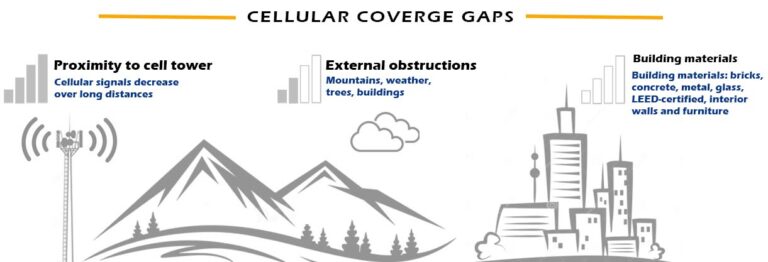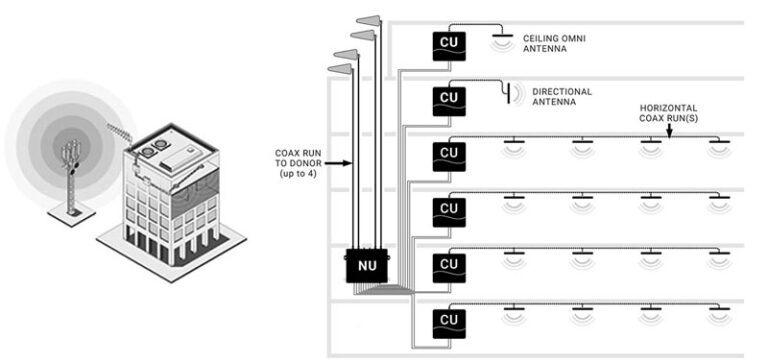Strong Signal is Essential to Businesses
Having a strong signal is essential to operate a business. If the cellular signal is poor, it can affect productivity. A stable cellular connection is the backbone of modern business infrastructures.
From dropped calls in high-rises buildings to slow speeds in undergound parkings, indoor cellular coverage remains a major challenge — even in the world’s most connected cities, where 80% of cellular traffic originates indoors. These gaps don’t just frustrate users; they jeopardize public safety, hurt property values, and drag down customer satisfaction scores for mobile network operators.
Do you need to improve cell service within your building? Discover DAS and in-building connectivity.
What Causes Poor Cellular Signal?
This is a simple representation of cellular coverage gaps and factors impacting cell signal in a building.
Poor cell reception in a building is often due to a building’s proximity to one or more cell towers. Cell towers transmit signals through the air to mobile devices and allow cellular connectivity. In most cases, these towers are dotted across the landscape and cover the entire city area properly so that a mobile device user or a building in a city is never too far away from a tower. However, when a building or an office is far away from a tower, the cellular signal strength can be poor.
The second cause resulting in poor coverage is the material used to construct a building. Thick building materials, such as steel and concrete, can decrease the strength of the signal while it penetrates the building or even stop it completely. Modern, highly energy-efficient buildings are not immune to a weak cellular signal, as many of these buildings are thickly insulated and soundproofed. Read our full articles on Building materials that block cellular service.
Finally, external obstructions are a factor that we also need to take into consideration. External factors such as weather, clouds, mountains, trees and density of the buildings.

DAS and In-Building Connectivity
Fully managed Direct Antenna System (DAS) exist for continuous high-speed wireless communications. We then get uninterrupted communications in buildings.
1. Ensure a reliable cellular network
To ensure a reliable and robust cellular network, the distributed antenna system (DAS) is a technology that addresses the challenges of signal penetration and coverage in large building complexes. This system uses a network of antennas strategically placed throughout a building or area to amplify cellular signals, ensuring consistent, high-quality coverage.

2. Cellular Distributed Antenna System (DAS) Service
VEGA offers a fully managed cellular DAS (Distributed Antenna System) network capable of delivering high-speed wireless communications in large, multi-story commercial buildings. Our managed service includes the design and deployment of a neutral, hosted DAS network, as well as working with leading wireless service providers to ensure seamless integration with that network.
We also facilitate the process to ensure tenants have access to a reliable wireless network with consistent, high-quality coverage.


